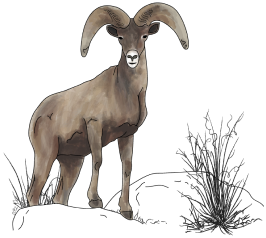Rhus aromatica var. trilobata Nutt.
Viridiplantae > Streptophyta > Streptophytina > Embryophyta > Tracheophyta > Euphyllophyta > Spermatophyta > Magnoliopsida > Mesangiospermae > eudicotyledons > Gunneridae > Pentapetalae > rosids > malvids > Sapindales > Anacardiaceae > Rhus > aromatica var. triloba [1]
![Rhus aromatica flower. Photo by Matt Lavin. [2]](/crfs/images/native-plants/plant-directory/fragrantsumac-first.jpg)
Rhus aromatica flower. Photo by Matt Lavin. [2]
Shrubs 0.5-2.5 m tall, spreading, forming small to large clumps or thickets; branchlets brown, becoming gray in age, densely puberulent; leaves trifoliate, thin, seldom if at all coriaceous, the leaflets 0.8-9.3 cm long, and 0.6-7 cm wide, lobed, ciliate, glabrous or puberulent on one or both sides; petioles puberulent; flowers in dense spikes or in short spicate panicles, mainly on short lateral branches, rarely terminal, yellowish, developing prior to the leaves, 2-3 mm long; sepals ca 1-1.5 mm long, often reddish; drupes red orange, 5-8 mm long, plants of mesic sites, widespread [3].
![Rhus aromatica, entire plant. Photo by Matt Lavin. [4]](/crfs/images/native-plants/plant-directory/fragrantsumac-sec.jpg)
Rhus aromatica, entire plant. Photo by Matt Lavin. [4]
There are two varieties of this species found in Utah; Rhus aromatica var. trilobata and R. aromatica var. simplicifolia. The biggest difference between the two is in the leaves. The variety simplicifolia has leaves that are coriaceous, or textured with a leather feel, where var. trilobata leaves are usually thin. The leaves of var. trilobata are also trifoliolate compared to the merely pinnately to subpalmately lobed simple leaves of var. simplicifolia. Lastly, var. simplicifolia is almost exclusively found in xeric (dry) sites of SE and SW Utah whereas var. trilobata is more widespread in its distribution but more oftenly associated with wetter sites. Other varieties are found in cultivation and easily form intermediates, or hybrids, with the indigenous varieties [3].
Based on morphology, Rhus species have been variously recognized as their own genus or within Schalmaltizia [5]. Since the advent of molecular systematics, however, DNA analysis supports the recognition of Rhus as its own genus [6].
![Rhus aromatica fruits. Photo by Stan Sheb. [8]](/crfs/images/native-plants/plant-directory/fragrantsumac-third.jpg)
Rhus aromatica fruits. Photo by Stan Sheb. [8]
The fruits of Rhus aromatica are edible and it is known to be used by the Midoo tribes as a food after being pounded into a puree [9]. However, the fruit does have large seeds compared to its thin flesh, so the amount of food each berry provides is small [2]. It is also known that indigenous people used the plants for basket making [2]. Lakota tribes mixed the leaves of these plants with tobacco leaves for smoking [10] and the Natchez would use a poultice of the roots as a medicine for boils and other skin ailments [11]. The Ojibwa would use the plants medicinally for gastrointestinal issues [12]. Today, the plant is commonly used as an ornamental shrub and decorates landscapes across the state.
![Distribution map of Rhus aromatica at a county level. [13]](/crfs/images/native-plants/plant-directory/fragrantsumac-fourth.jpg)
Distribution map of Rhus aromatica at a county level. [13]
Rhus aromatica was last assessed for NatureServe 16 May 2016 and is considered secure [14].
Rhus aromatica var. trilobata is specifically found in areas where water accumulates, such as stream banks, terraces, seep and spring margins, and on mesic slopes. This plant is commonly found in riparian plant communities [2].
The two varieties of Rhus aromatica found in Utah differ because of their need to adapt to water availability. The thicker, more textured leaves of var. simplicifolia have most likely evolved to be able to retain water and are found in the dryer parts of the state. Var. trilobata grows in places where it is not necessarily advantageous to have differences in leaf structure to retain water, therefore the adaptation hasn’t been passed through the generations and the varieties have started to separate with small but distinct differences. The two varieties can interbreed and form hybrids between the two distributions and are found on a gradient between the dry deserts and the wet riparian stream banks.
[1] Schoch CL, et al. NCBI Taxonomy: a comprehensive update on curation, resources and tools. Database (Oxford). 2020: baaa062. PubMed: 32761142 PMC: PMC7408187.
[2] Lavin, M.. Photograph https://www.flickr.com/photos/plant_diversity/26798260262 /in/album-72157675349157352/
[3] Welsh, S. L., Atwood, N. D., Goodrich, S., & Higgins, L. C. (2016). A Utah flora (Third). Monte L. Bean Life Science Museum.
[4] Lavin, M. Photograph https://www.flickr.com/photos/35478170@N08/5020619321
[5] Brizicky, G. K. (1963). TAXONOMIC AND NOMENCLATURAL NOTES ON THE GENUS RHUS (ANACARDIACEAE). Journal of the Arnold Arboretum, 44(1), 60–80. http://www.jstor.org/stable/43781452
[6] YI, T.; MILLER, A. J.; WEN, J. Phylogeny of Rhus (Anacardiaceae) Based on Sequences of Nuclear Nia-i3 Intron and Chloroplast trnC-trnD. Systematic Botany, [s. l.], v. 32, n. 2, p. 379–391, 2007. Disponível em:
[7] Auger, J., Meyer, S. E., & Black, H. L. (2002). Are american black bears (Ursus americanus) legitimate seed dispersers for fleshy-fruited shrubs? The American Midland Naturalist, 147(2), 352–367. https://doi.org/10.1674/0003-0031(2002)147[0352:aabbua]2.0.co;2
[8] Shebs, S. Photograph. https://commons.wikimedia.org/wiki/File:Rhus_trilobata_6.jpg
[9] Merriam, C. Hart, 1966, Ethnographic Notes on California Indian Tribes, University of California Archaeological Research Facility, Berkeley, page 312
[10] Rogers, Dilwyn J, 1980, Lakota Names and Traditional Uses of Native Plants by Sicangu (Brule) People in the Rosebud Area, South Dakota, St. Francis, SD. Rosebud Educational Society, page 32
[11] Swanton, John R, 1928, Religious Beliefs and Medical Practices of the Creek Indians, SI-BAE Annual Report #42:473-672, page 667
[12] Hoffman, W.J., 1891, The Midewiwin or 'Grand Medicine Society' of the Ojibwa, SI-BAE Annual Report #7, page 201
[13] USDA, NRCS. 2022. The PLANTS Database (http://plants.usda.gov), 09/28/2022). National Plant Data Team, Greensboro, NC USA.
[14] "Rhus aromatica Fragrant Sumac.” NatureServe Explorer 2.0, https://explorer.natureserve.org/Taxon/ELEMENT_GLOBAL.2.146377/Rhus_aromatica



